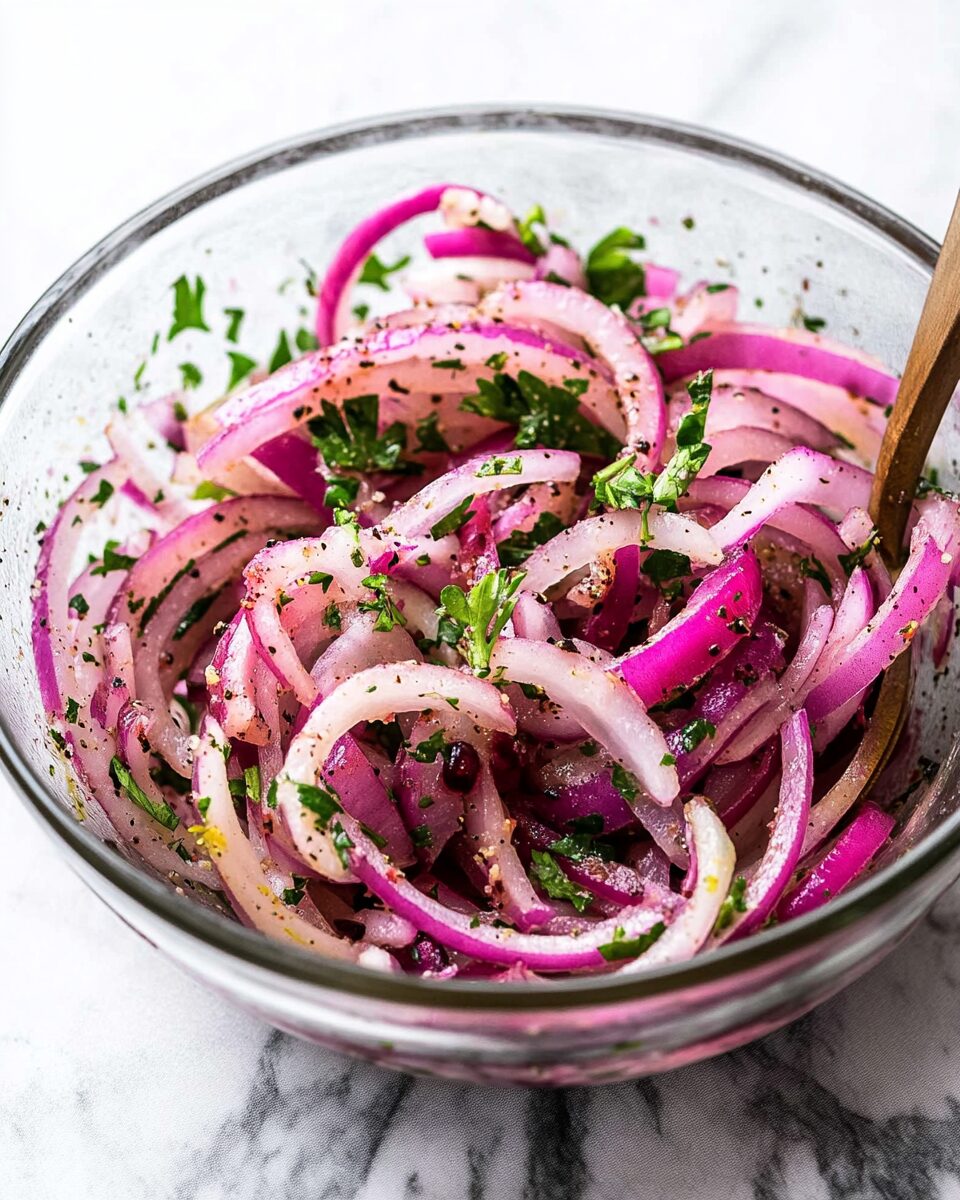Sumac Onions, a vibrant Turkish salad, bring together the sharp bite of red onions with the tart brightness of lemon and sumac. This simple yet flavor-packed dish is often served as a meze or as a topping for grilled meats, kebabs, or falafel wraps. The sumac adds a signature citrusy depth, while fresh parsley adds a green, herbaceous pop. This salad is a fantastic way to elevate everyday meals with minimal effort. It comes together in just minutes and can be made ahead of time to let the flavors deepen. Whether you’re building a Mediterranean mezze platter or looking to add more zest to your sides, this dish is a must-have in your culinary arsenal.
Full Recipe:
Ingredients:
-
1 large red onion, thinly sliced
-
2 tablespoons olive oil
-
1 tablespoon ground sumac
-
1 teaspoon salt
-
1/2 teaspoon black pepper
-
1/4 cup chopped fresh parsley
-
Juice of 1 lemon
-
Optional: 1 teaspoon pomegranate molasses for added sweetness
Directions:
-
Place the thinly sliced red onions in a bowl. Sprinkle with salt and let sit for 5–10 minutes to soften and reduce bitterness.
-
Add the olive oil, ground sumac, black pepper, and lemon juice to the bowl.
-
Toss everything together until the onions are evenly coated.
-
Mix in the chopped parsley and let the salad sit for 10–15 minutes to allow the flavors to develop.
-
Optional: Drizzle with pomegranate molasses for a touch of sweetness and depth.
-
Serve as a zesty side dish, salad topping, or kebab garnish.
Prep Time: 10 minutes | Cooking Time: 0 minutes | Total Time: 10 minutes
Kcal: 90 kcal | Servings: 4 servings
The Bright, Tangy Allure of Sumac Onions: A Turkish Culinary Treasure
In the vast, flavorful landscape of Middle Eastern and Mediterranean cuisine, some dishes captivate with their complexity, while others shine with simplicity. Sumac Onions, also known as Turkish Onion Salad, fall decisively into the latter category a dish so unassuming in appearance yet brimming with bold flavor and historical significance. Whether you’re a seasoned lover of Levantine fare or just discovering the region’s culinary charm, this zesty onion salad is a must-have addition to your table.
What Are Sumac Onions?
At its core, Sumac Onions is a simple preparation of thinly sliced red onions mixed with ground sumac, a tart red-purple spice, and often enhanced with olive oil, lemon juice, parsley, and sometimes pomegranate molasses. The dish is incredibly versatile and often served as a side, salad, or condiment. It’s commonly found alongside grilled meats, kebabs, kofta, or falafel, but it’s also a flavorful companion to wraps, rice bowls, and roasted vegetables.
Despite its humble ingredient list, the flavors of this dish are incredibly layered sharp and bright, with a citrusy zing from the sumac and lemon juice, earthy freshness from the parsley, and a mellowed onion sharpness thanks to a quick salt rub that softens the onion’s bite.
The Cultural Context: More Than Just a Side Dish
To understand the beauty of Sumac Onions, you have to appreciate the culinary culture from which it originates. In Turkish cuisine, and more broadly throughout the Levant and Middle East, food is not just nourishment; it’s a celebration of fresh ingredients and time-honored traditions. Meze platters (small plates served as appetizers) are a foundational element in these cuisines, designed for sharing and often accompanied by bread, olives, cheese, and various dips and salads.
Sumac Onions are a staple on such platters. They provide a burst of flavor that contrasts beautifully with richer dishes like lamb kebabs, grilled chicken wings (kanat), or hearty bean stews (kuru fasulye). The acidic brightness helps cut through fatty meats and balances the meal with its refreshing crunch and tart edge.
Why Sumac is the Star Ingredient
If you’re unfamiliar with sumac, you’re in for a treat. Derived from dried and ground berries of the wild sumac bush, this spice is a game-changer in any kitchen. It offers a lemony tartness without the harsh acidity of citrus a subtle, fruity tang that enhances rather than overpowers.
Sumac has been used for centuries across the Middle East, Turkey, and Iran, not just for its flavor but also for its medicinal properties. Rich in antioxidants and known for its anti-inflammatory benefits, sumac is a healthy addition to the diet. It’s also naturally gluten-free and vegan, making it suitable for a wide range of dietary lifestyles.
When used in this onion salad, sumac not only contributes to the color and aroma but also mellows the onion’s sharpness, making it palatable and even addictive to eat raw.
The Role of Onions in Turkish and Middle Eastern Cuisine
Onions are a foundational ingredient across the world, but in Turkish and Middle Eastern cuisines, they carry more weight than just being an aromatic base for soups or stews. They are celebrated in their own right often eaten raw, pickled, or as part of salads and relishes.
The red onion in this dish is carefully sliced and then salted to reduce its pungency. This quick curing process removes the harsh bite of raw onion, leaving behind a slightly sweet, tender crunch that pairs wonderfully with the sumac and lemon.
This approach to onion preparation is deeply rooted in tradition, yet incredibly modern in practice. It’s a culinary trick worth adding to your everyday cooking transforming an ingredient many find overpowering into a vibrant, nuanced delicacy.
Variations and Serving Suggestions
One of the best things about Sumac Onions is how adaptable they are. You can tweak the basic recipe to suit your taste or to match the theme of your meal.
Here are a few ideas:
-
Add pomegranate molasses: This thick, tangy syrup adds a slight sweetness and depth to the salad. Just a drizzle can completely elevate the dish.
-
Include thinly sliced radishes or cucumbers: For more crunch and color, and to stretch the salad for a larger gathering.
-
Use white onions: If red onions are too strong for your preference, white onions (or even sweet onions) can be a milder alternative.
-
Top with toasted nuts or seeds: Such as pine nuts or sesame seeds for texture and a nutty richness.
-
Stuff into sandwiches or wraps: A spoonful of sumac onions adds a punch to falafel wraps, grilled chicken sandwiches, or lamb gyros.
-
Serve over hummus or labneh: For a dynamic dip presentation that contrasts creamy and tangy elements.
As a garnish or side, sumac onions will breathe new life into otherwise basic meals — even something as simple as grilled fish or rice bowls can benefit from the sharp and fresh layers this salad brings.
Health Benefits of This Simple Side
This dish is more than just flavorful it’s incredibly nutritious. Onions are rich in antioxidants, including quercetin, which has anti-inflammatory and antibacterial properties. When paired with sumac, which itself contains polyphenols and flavonoids, this dish becomes a mini superfood side.
Olive oil and lemon juice also bring heart-healthy fats and vitamin C into the mix. For those following gluten-free, vegan, or low-calorie diets, this recipe ticks all the right boxes. It’s also keto-friendly and paleo-approved, depending on how you pair it.
Advertisement
Storage and Make-Ahead Tips
Sumac Onions are one of those magical dishes that tastes better over time. Once mixed, the flavors continue to meld, and the onions soften even more, making this an ideal make-ahead dish. Store it in an airtight container in the refrigerator, and it will keep well for up to 3–4 days.
Just be aware: the onion aroma can be strong if left uncovered so seal it tight and let it continue marinating until it’s ready to serve.
Conclusion:
Whether you’re hosting a Middle Eastern feast, looking to spice up your weeknight dinners, or simply craving something different, Sumac Onions are an effortless way to add depth, flavor, and authenticity to your meals.
Despite its simplicity, this dish exemplifies everything we love about traditional Turkish cuisine fresh ingredients, balanced flavor profiles, and a deep respect for time-honored methods. Once you make it, you’ll find yourself returning to it again and again, not just for its taste but for the way it brings your entire meal to life.

